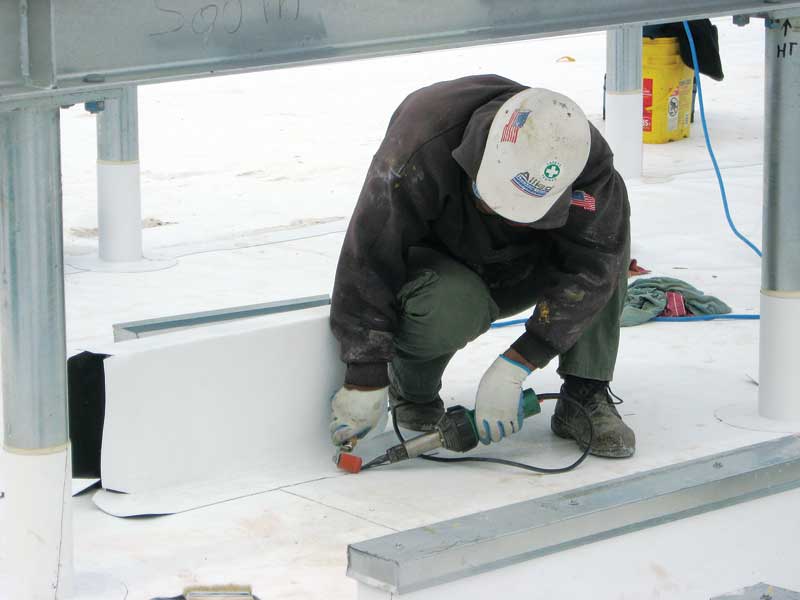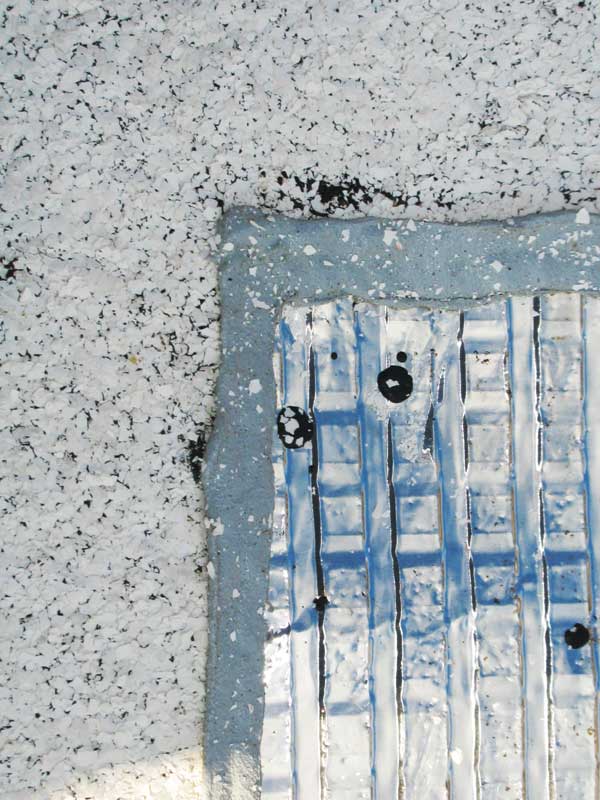
Energy codes and performance requirements for cool roofs
Also known as reflective or white roofs, cool roofs have a high solar reflectance or albedo, which means they reflect sunlight much better than do traditional roofs. By radiating energy back into the atmosphere, cool roofs’ high thermal emittance allows them to reduce solar heat loads on the building. Like vegetated assemblies, cool roofs help reduce the trapped heat in urban areas known as the ‘heat island effect,’ which, in turn, cuts levels of air pollutants contributing to smog.
In response to concerns that reflective roof surfaces in northern climates actually increase energy consumption by requiring additional heating in the winter, American Society of Heating, Refrigeration, and Air-conditioning Engineers (ASHRAE) 90.1, Energy Standard for Buildings Except Low-rise Residential Buildings, was revised as of the 2010 edition to specify cool roofs solely for warm climates; in previous editions, reflective roof assemblies were the standard, irrespective of geographic region. However, there is some contradictory evidence the assemblies reduce energy consumption across all North American climate zones.
According to a recent study by the Oak Ridge National Laboratory (ORNL), even in colder climates, cool roofs can significantly reduce peak energy demand. (For more, see T.W. Petrie et al’s 2004 paper, “Effect of Solar Radiation Control on Electricity Demand Costs: An Addition to the DOE Cool Roof Calculator,” from the ASHRAE Performance of Exterior Envelopes of Whole Buildings IX International Conference Proceedings.) When installed with appropriate insulation, cool roofs were shown to cut peak energy use enough to compensate for increases in winter heating caused by the roof reflectivity, resulting in an overall net energy savings. However, this energy savings may depend on other factors, including whole building envelope thermal performance and type of heating fuel used.
To guide building owners, managers, and project teams in determining potential energy savings, the Department of Energy (DOE) provides an online tool, the “Cool Roof Peak Calculator,” for low-slope commercial and institutional roof assemblies.

Energy use calculations aside, the decision to install a cool roof on a building may be mandated by code. The 2014 New York City Building Code requires new roof coverings on all low-slope roofs (i.e. less than 17 percent grade) meet minimum reflectance requirements, with the exception of:
- vegetated roofs and other types of landscaped areas or usable plazas;
- very small terraces or setbacks;
- areas under rooftop equipment;
- roofs used as playgrounds;
- certain roof types; and
- other case-specific instances.
The New York City Energy Conservation Code, adopted in January 2015, also incorporates requirements for roof reflectivity, with tables for acceptable solar reflectance and thermal emittance values.
Similarly, the Washington D.C. Energy Conservation Code, based on the 2012 International Energy Conservation Code (IECC), includes stipulations for reflective roofs. According to the Cool Roof Rating Council (CRRC), dozens of other states and cities have adopted ASHRAE or IECC standards that include provisions mandating cool roofs. (Examples include Connecticut, Delaware, Massachusetts, Maryland, New Jersey, Virginia, Pennsylvania, New Hampshire, and Rhode Island.)
High-albedo roof assemblies
In response to these codes and standards, and to the increased demand for energy-saving roofing options, roofing manufacturers have increased their product lines for reflective roof assemblies. To meet baseline requirements for current national standards, a cool roof must have a minimum initial solar reflectance
(i.e. fraction of incident solar energy reflected by the surface) of 0.70 and thermal emittance (i.e. measure of a material’s ability to release absorbed heat) of 0.75. When aged three years, solar reflectance may be reduced to no less than 0.55, and thermal emittance must remain at 0.70 or greater. Values for solar reflectance and thermal emittance are calculated on a scale of 0 to 1, with 0 being a black roof that absorbs 100 percent of solar energy, and 1 being a perfectly reflective roof.





What a nice overview of these issues. Vegetative/green roofs are a great amenity for inhabitants and building owners and EPDM membrane is commonly used as the roof cover. A small correction … prior to the 2010 edition of ASHRAE 90.1, there was no requirement for roof reflectivity. That provision was added for the 2010 edition in Climate Zones 1-3. Your statement of “…in previous editions, reflective roof assemblies were the standard, irrespective of geographic region” is incorrect.
Green roofs have become incredibly popular and are being designed and installed at an incredibly rapid pace. As an addition to the “Waterproof design” in this article, I would strongly recommend installing a conductive mesh beneath the waterproof membrane. This will now, always allow for an Electronic Leak Detection to be performed after completion of such elaborate vegetated roofs and/or any other amenity space idea. My company specializes in both high and low voltage testing (leak/integrity), Gaussen’s “Real Time Leak Detection and Alert Systems” (24/7 live monitoring) as well as installing the conductive mesh.
The recommendation to perform a leak detection prior to installing the green roof components is spot on and will only save time, money and frustration. You can find our specification for Electronic Leak Detection at http://atlanticleak.com/eld-specification/.
Great article!!